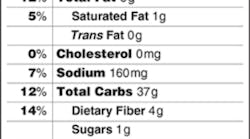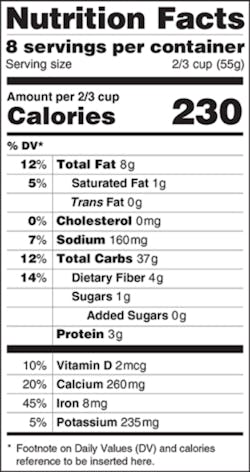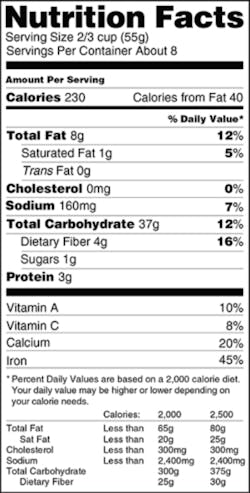The U.S. Food and Drug Administration (FDA) is preparing to update the Nutrition Facts label for packaged foods to reflect the latest scientific information, including the link between diet and chronic diseases such as obesity and heart disease.
The proposed label also would replace outdated serving sizes to better represent the amounts people actually consume. It would also have a new design to highlight key parts of the label, such as calories and serving sizes. The FDA would like it to be easier for consumers to make better informed food choices that will support a healthy diet.
PROPOSED LABEL FORMAT (above left) along with CURRENT LABEL FORMAT (above right) Some of the proposed changes to the label the FDA would:(1) • Require information about the amount of “added sugars” in a food product. The 2010 Dietary Guidelines for Americans states that intake of added sugar is too high in the U.S. population and should be reduced.(2) The FDA proposes to include “added sugars” on the label to help consumers know how much sugar has been added to the product. • Update serving size requirements to reflect the amounts people currently eat. • Present “dual column” labels to indicate both “per serving” and “per package” calorie and nutrition information for larger packages that could be consumed in one sitting or multiple sittings. • Require the declaration of potassium and vitamin D, nutrients that some in the U.S. population are not getting enough of, which puts them at higher risk for chronic disease. • Revise the Daily Values for a variety of nutrients such as sodium, dietary fiber and Vitamin D. • While continuing to require “Total Fat,” “Saturated Fat,” and “Trans Fat” on the label, “Calories from Fat” would be removed because research shows the type of fat is more important than the amount. • Refresh the format to emphasize certain elements, such as calories, serving sizes and Percent Daily Value, which are important in addressing current public health problems like obesity and heart disease.(1)
For more information, see Nutrition Facts at a Glance, or Proposed Changes to the Nutrition Facts Label.(3) Another interesting note is that a study reviewed what added sugar intake did to cardiovascular disease mortality among US adults.(4) According to the authors, epidemiologic studies have proposed that higher intake of added sugar is connected to cardiovascular disease (CVD) risk factors. However, limited prospective studies have studied the relationship of added sugar intake with CVD mortality. The objective of this study was to inspect time trends of added sugar ingestion as a percentage of daily calories in the United States, and investigate the association of this consumption with CVD mortality. They looked at a total daily consumption of sugars added to products during manufacturing, not naturally occurring sugars, as in fresh fruit, in excess of dietary limits recommended by expert panels. In the past, excessive sugar was often related to obesity and dental caries. The new paradigm assesses excessive sugar consumption as an independent risk factor in CVD as well as many other chronic diseases, including diabetes mellitus, liver cirrhosis, and dementia. These are all connected to metabolic concerns about dyslipidemia, hypertension, and insulin resistance.(5) Using NHANES date, they measured cardiovascular disease mortality. They found that most U.S. adults ingest more added sugar than is recommended for a healthy diet. They observed a significant relationship between added sugar consumption and increased risk for CVD mortality.(4)
(6) In a recent New York Times article, First Lady Michelle Obama talked about the evidence-based Let’s Move Initiative. Because studies showed that children required less sugar, salt and fat in their diets, they overhauled school lunch menus.(6,7) They also focused on getting more fresh-food retailers in underserved areas, and encouraging exercise and physical activity. As dental hygienists and dentists, we should be providing nutrition counseling to our patients. There are online courses and articles on diet and nutrition. Diet and Nutrition Implications for Oral Health (8); Nutrition & Oral Health: Eating Well for a Healthy Mouth (9); and The Dental Hygienist's Guide to Nutritional Care, 3e (Evolve Learning System Courses.(10)RELATED | Celebrate National Nutrition Month: nutrition facts, label programsReferences 1. http://www.fda.gov/NewsEvents/Newsroom/PressAnnouncements/ucm387418.htm. 2. http://www.cnpp.usda.gov/publications/dietaryguidelines/2010/policydoc/policydoc.pdf. 3. http://www.fda.gov/Food/GuidanceRegulation/GuidanceDocumentsRegulatoryInformation/LabelingNutrition/ucm385663.htm. 4. Yang Q, Zhang Z, Gregg EW, Flanders WD, Merritt R, and Hu FB. Added Sugar Intake and Cardiovascular Diseases Mortality Among US Adults. JAMA Intern Med. 2014; 174(4):516-524. doi:10.1001/jamainternmed.2013.13563. 5. Schmidt LA. New Unsweetened Truths About Sugar. JAMA Intern Med. 2014; 174(4):525-526. doi:10.1001/jamainternmed.2013.12991. 6. http://www.letsmove.gov/. 7. NY Times. May 28, 2014. http://www.nytimes.com/2014/05/29/opinion/michelle-obama-on-attempts-to-roll-back-healthy-reforms.html?_r=1. 8. http://www.adha.org/ce-course-7. 9. http://www.dentalcare.com/en-US/dental-education/continuing-education/ce301/ce301.aspx?ModuleName=coursecontent&PartID=9&SectionID=-1. 10. http://www.amazon.com/Dental-Hygienists-Nutritional-Learning-Courses/dp/1416063986.More by Maria Perno Goldie:Protecting our childrenAre you screening in your dental office?
Maria Perno Goldie, RDH, MS, is the editorial director of RDH eVillage FOCUS.











